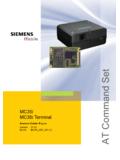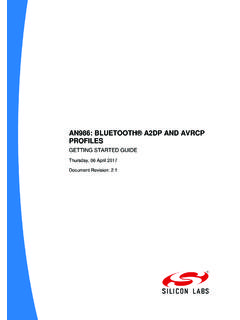Transcription of Downloading and Installing Google SketchUp
1 Introduction to SketchUp This guide is handy to read if you need some basic knowledge to get started using SketchUp . You will see how to download and install SketchUp , and learn how to use your mouse (and what kind of mouse you need). You will also get a basic overview of the user interface, and learn how to use many of the basic SketchUp tools. Downloading and Installing Google SketchUp 1. If you don't have SketchUp , go to and click the Download SketchUp button. 2. SketchUp Make is the free version, which is all you need for personal or educational use. Once you enter your email address and agree to the terms, click the Download SketchUp Make button. 3. Follow the installation instructions, and once finished, you'll see the SketchUp icon on your desktop. Double-click this icon to open SketchUp . Page 1. 4. In the Welcome to SketchUp window, click Choose Template, and choose one of the templates from the list.
2 Then click Start Using SketchUp . The Mouse You might already have a perfect mouse, but if not, you should get one! What you should have is a three-button, scroll wheel mouse. Here are some examples: If you are using SketchUp on a laptop or notebook computer, you might not have a separate mouse. Instead, you may have a track pad with two mouse buttons, like these examples: It is quite difficult to use SketchUp properly on a laptop, with buttons and pads like these. So you really should attach a real mouse to the laptop. Page 2. Using a three-button wheel mouse has two huge advantages: 1. The scroll wheel can be used to zoom in and out (making the objects appear larger or smaller). 2. The middle mouse button can be used for orbiting (spinning the model around). If you have a scroll-wheel in the middle, the scroll wheel IS the middle mouse button - you can both scroll it and click it. The right mouse makes it easy to move around in your model - it's a good deal harder to maneuver around with a lesser mouse!
3 If you install a new mouse, it comes with setup software, which you can use to set what each mouse button does. If you already have a mouse, and the buttons aren't doing what you expect them to, open your computer's mouse settings. Most mouse drivers have options to set what each mouse button does. Make sure you set: Left button = click Right button = Right-click Wheel button = Scroll (yours might say AutoScroll ). If there's a separate option for Middle Button, set it to Middle-click.. Some mice have extra buttons, such as small ones on either side. You can set one of these to double-click, which will save your clicking finger from some extra work! ( SketchUp uses a lot of double-clicking.). Toolbars, Menus, Icons This is the menu and the main toolbar you'll see when first opening SketchUp . Here you can access most, if not all, the drawing and editing tools you'll be using. There are many more toolbars available, which you can find by choosing View / Toolbars (Mac: View / Customize Toolbars).
4 From the menu that appears, click any toolbars you want to see. (What you see on your list may look different; Installing plugins adds more toolbars to the list.) Once displayed, you can move toolbars to different locations, by clicking and dragging their title bars around the screen. Page 3. Mac users: drag the toolbar you want to see onto the main toolbar. If you don't feel like clicking icons or going the main menu each time you want to use a tool, you should get to know the keyboard shortcuts. If you look at the menus, you can see the shortcuts listed next to each tool (for example, L for Line, M for Move, or E for Eraser). To use a shortcut, just press the letter or key on the keyboard. So if you want to use Move, just press the M key. This is very useful for tools you use very often, such as Select (whose shortcut key is the Spacebar). If you want to change a shortcut to a different key, or set a shortcut for a tool that doesn't have a shortcut, choose Window / Preferences (Mac: SketchUp / Preferences) and open the Shortcuts page.
5 Zooming, Panning, and Orbiting It's crucial in SketchUp that you understand how to navigate and explore in your model. There are icons for zooming, panning, and orbiting tools. But to make it very easy to move around, you really, really need a three-button scroll wheel mouse. With the right mouse, you never have to click any of these tools - you just use your mouse buttons and (sometimes) keys on your keyboard. Orbit Orbiting is like holding an object and turning it around. When you use this tool, click and hold the mouse button and move the mouse around. Where your cursor is on the screen will be the center of rotation. It takes some getting used to, so try using Orbit with your cursor in different places. Here's a much easier way to orbit: If you have a three-button mouse, just press and hold the middle mouse button while moving the mouse. If your middle mouse button is a scroll wheel, just click the wheel and hold it down.
6 Page 4. You can mouse-orbit even if you're in the middle of using another tool - when you release the middle mouse button, you're back in the tool you were already using. Pan Panning means sliding your view up or down, left or right. It's similar to moving a piece of paper across a desk. To pan the view, activate Pan and hold and drag the mouse. If you have a three-button mouse, you can pan by pressing Shift while orbiting. This means holding the middle mouse button, pressing Shift, and dragging the mouse around. Zoom Click and drag the mouse up to zoom in, down to zoom out. With a wheel mouse, you can scroll the mouse wheel up or down to zoom. If you are using your scroll wheel, place your mouse where you want the zoom to be centered. It sounds confusing, but try zooming with your cursor in different places, to see what this means. If you zoom so far in or out that you can't see your model anymore, click Zoom Extents.
7 That will fit everything back on your screen. Overview of SketchUp 's Basic Tools All of SketchUp 's drawing and editing tools are available from the main menu, and on the main toolbar across the top of the screen. Most of these can be activated by a shortcut key, too. Select Menu: Tools / Select, shortcut: Spacebar You need to select objects (edges and/or faces) before the objects can be moved, copied, scaled, etc. You can also use Select to erase objects: Select them, then press the Delete key. Page 5. When you activate Select and click on an object, it will be highlighted. You can select more than one object by pressing Shift or Ctrl (Mac: Option) while clicking. (Shift toggles what's selected - if something is already selected, Shift and Select will unselect it. Ctrl / Option will only add to what's selected.). When you want to select multiple objects, it's often easiest to use a selection window.
8 This means holding the mouse and dragging a rectangle around what you want to select. The way you drag the window makes a difference: if the window goes from left to right, you'll select only what's completely inside. If the window goes from right to left, you'll select everything completely inside AND everything that touches the window. If you double-click on a face, you'll select both the face and its edges. This comes in handy! And triple-clicking means everything connected to the selected object will also be selected. Line Menu: Draw / Lines / Line, shortcut: L. This tool draws (surprise!) lines, also known in SketchUp as edges. Click the first endpoint, then click the second endpoint. If you're finished making lines but the tool has started a new line, press the Esc (Escape) key. (You can also activate a new tool if you ever want to cancel the current tool.) If you draw lines that form a closed shape, like a triangle or rectangle, SketchUp will automatically create a face inside the lines.
9 Rectangle Menu: Draw / Shapes / Rectangle, shortcut: R. To draw a rectangle, click one corner, and then click the opposite corner. If you want to draw a square, wait to see the Square popup before clicking that second corner point. Circle Menu: Draw / Shapes / Circle, shortcut: C. To draw a circle, first click the center point, then click an outside point. Page 6. A circle is actually a set of short line segments; the default number of sides is 24 which is fine for almost all models. If you need a more realistic circle, you can use a higher number of sides. To set the number of sides, activate Circle and then immediately type the number of sides you want, and press Enter. To change the number of sides of a circle you just made, type 100s to change the number to 100 sides (for example). Warning: a high number of sides can slow down your model! Arc Tools Menu: Draw / Arcs There are three ways to draw an arc.
10 The simplest is 2 Point Arc (shortcut: A), which creates in arc in three clicks. The first click sets the start point, then the end point, then a point in the middle (the bulge point). Like with circles, an arc is actually made of short line segments, and you can change the number of sides like you would for a circle. The second arc tool (Arc) first sets the center point, then the two points at either end. Pie is similar, but fills in a pie-shaped face. Polygon Menu: Draw / Shapes Polygon When you first activate Polygon, before clicking any points, you'll see the number of sides listed in the Sides box, located by default below the SketchUp window. If you want a different number of sides, type the number and press Enter. (For example, if you enter 3, you'll create a triangle, if you enter 6, you'll create a hexagon.). Then create the polygon like a circle - first the center point, then an outside point.






